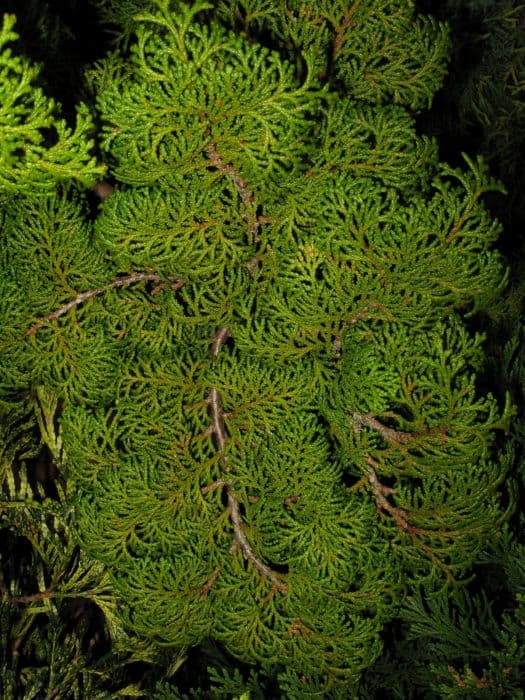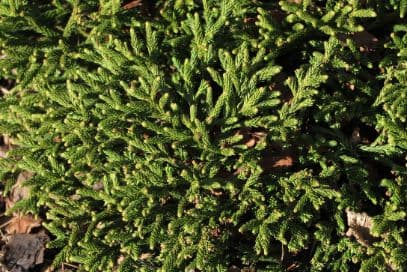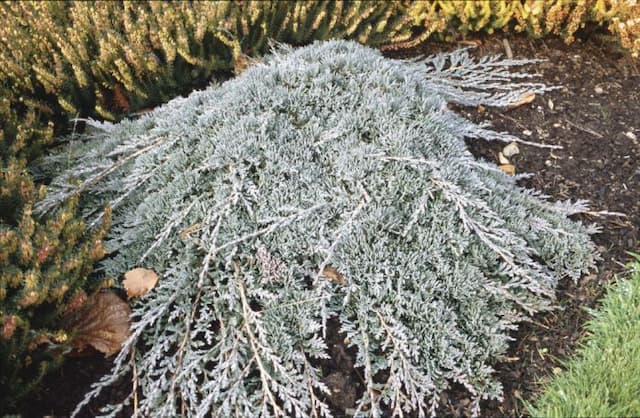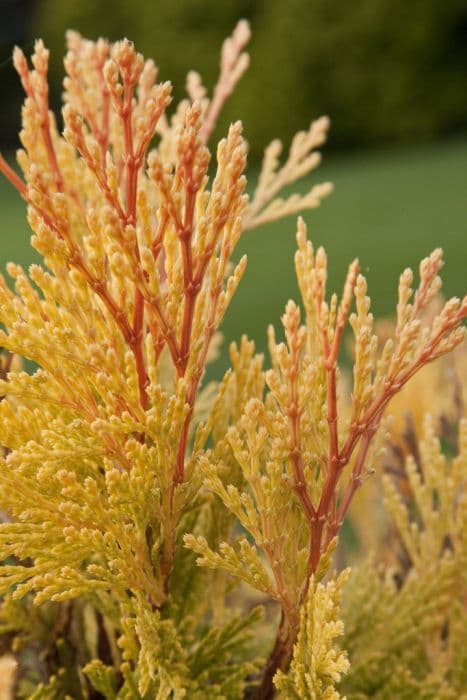Arizona Cypress Cupressus arizonica var. glabra 'Blue Ice'

ABOUT
The 'Blue Ice' Arizona Cypress is an evergreen conifer known for its striking foliage. It features beautiful silvery-blue needles that are densely packed along the branches, creating a visually appealing texture. The needles are scale-like, very aromatic when crushed, and give the plant a frosty appearance, as though it were dusted with snow or ice. The shape of 'Blue Ice' is naturally conical, with a symmetrical form that tapers to a point at the top. This neat, pyramid-like shape is maintained without the need for regular trimming. Its branch structure is both sturdy and dense, providing a solid screen when used for privacy or windbreak. The bark of the 'Blue Ice' is smooth and gray when the tree is young, becoming more furrowed and ridged as it matures. This tactile contrast adds an interesting element to the garden landscape. The cones of this Arizona Cypress variant are small and inconspicuous, blending in with the silvery-blue foliage. The cones mature to a woody, brown color, often going unnoticed amidst the dense needle coverage. With its eye-catching blue foliage and neat conical form, the 'Blue Ice' Arizona Cypress is often used as an ornamental feature in landscape design, providing a cool-toned contrast against the greens of other garden plants. It is favored for its low maintenance requirements and its resilience to a variety of conditions once established.
About this plant
 Names
NamesFamily
Cupressaceae
Synonyms
Arizona Cypress, Smooth Arizona Cypress, Blue Ice Cypress
Common names
Hesperocyparis arizonica var. glabra 'Blue Ice', Callitropsis arizonica var. glabra 'Blue Ice', Cupressus arizonica 'Blue Ice'.
 Toxicity
ToxicityTo humans
Arizona Cypress, specifically the 'Blue Ice' cultivar, is not commonly known to be toxic to humans. There is limited information about its toxicity, but it is generally considered safe and does not pose a significant threat if touched or ingested in small quantities. However, it is always prudent to exercise caution and avoid ingesting plant parts, as individual sensitivities can vary and the potential for a mild allergic reaction or irritation cannot be completely ruled out.
To pets
Arizona Cypress 'Blue Ice' is not widely recognized as a toxic plant to pets. While the toxicity of this particular cultivar to pets has not been extensively documented, most cypresses are considered non-toxic to cats and dogs. Pets that ingest parts of the plant may experience mild gastrointestinal discomfort, but significant toxic effects are not typically expected. As with any non-food plant, ingestion should still be discouraged, and pet owners should monitor their animals for any signs of distress after ingestion.
 Characteristics
CharacteristicsLife cycle
Perennials
Foliage type
Evergreen
Color of leaves
Blue-green
Height
15-30 feet (4.6-9.1 meters)
Spread
10-15 feet (3-4.6 meters)
Plant type
Tree
Hardiness zones
6-9
Native area
Southwestern USA
Benefits
 General Benefits
General Benefits- Aesthetic Appeal: 'Blue Ice' Arizona Cypress offers intense silvery-blue foliage that provides stunning visual interest and contrast in the landscape.
- Drought Tolerance: Once established, this variety is quite tolerant of dry conditions, making it suitable for xeriscaping and water-wise gardens.
- Low Maintenance: Requiring minimal pruning and care, it is an excellent choice for gardeners seeking hardy, low-maintenance plants.
- Privacy Screen: With its dense growth habit, 'Blue Ice' can be used effectively as a living screen or hedge for privacy.
- Windbreak: Its sturdy structure can serve as a windbreak, protecting other garden plants and reducing wind erosion.
- Soil Stabilization: The extensive root system of this cypress helps stabilize the soil, preventing erosion on slopes and in other vulnerable areas.
- Habitat for Wildlife: Offers shelter and nesting sites for birds, and its cones can provide a source of food for wildlife.
- Adaptability: Able to thrive in various soil types, 'Blue Ice' cypress is versatile and can be grown in different landscape settings.
- Seasonal Interest: Provides year-round interest due to its evergreen nature, with an added appeal during the winter months when other plants have lost their leaves.
 Medical Properties
Medical PropertiesThis plant is not used for medical purposes.
 Air-purifying Qualities
Air-purifying QualitiesThis plant is not specifically known for air purifying qualities.
 Other Uses
Other Uses- Privacy Screening: 'Blue Ice' Arizona cypress can be used as a natural privacy screen due to its dense foliage, which can grow together to create a visual barrier between properties.
- Windbreaks: This variety of Arizona cypress can be planted in a row to serve as a windbreak, reducing wind speed and protecting areas from harsh winds.
- Theme Gardens: The striking blue color of 'Blue Ice' adds a unique touch to themed gardens, such as rockeries or xeriscapes, complementing other plants and elements.
- Noise Reduction: When planted in mass, 'Blue Ice' Arizona cypress can help absorb sound, making it suitable for planting along roads or highways to reduce traffic noise.
- Erosion Control: The robust root system of 'Blue Ice' helps stabilize the soil and prevent erosion on slopes or in areas prone to soil degradation.
- Topiary and Ornamental Shapes: With regular pruning, 'Blue Ice' can be trained into various shapes or topiaries for decorative purposes in formal gardens.
- Christmas Trees: Due to its conical shape and evergreen foliage, 'Blue Ice' can be used as a living Christmas tree that can be decorated outdoors.
- Cultural and Religious Significance: In some cultures, evergreen trees like 'Blue Ice' are symbolic and are used in ceremonial plantings or as part of religious festivities.
- Wildlife Habitat: 'Blue Ice' provides a habitat for birds and other wildlife, offering shelter and sometimes even food in the form of its cones or small branches.
- Photography and Painting Subjects: The distinctive blue hue and texture of the 'Blue Ice' make it a popular subject for photographers and painters, especially in landscape art.
Interesting Facts
 Feng Shui
Feng ShuiThe Arizona cypress is not used in Feng Shui practice.
 Zodiac Sign Compitability
Zodiac Sign CompitabilityThe Arizona cypress is not used in astrology practice.
 Plant Symbolism
Plant Symbolism- Endurance and Strength: Arizona Cypress, including the 'Blue Ice' variety, is known for its hardy nature and ability to withstand tough conditions. This symbolizes the ability to endure hardships and maintain strength over time.
- Eternal Life: Evergreens like the Arizona Cypress are often associated with immortality and eternal life because they maintain their needles throughout the year.
- Protection: The dense foliage and height of the Arizona Cypress provide shelter and protection for wildlife, representing safety and security.
- Purity: The fresh and clean scent of the Arizona Cypress, particularly 'Blue Ice' with its silvery-blue foliage, symbolizes purification and clean beginnings.
 Water
WaterArizona Cypress 'Blue Ice' should be watered deeply and infrequently to promote strong root growth. Newly planted trees will need more frequent watering to establish roots, typically once a week with about 5 gallons of water during the growing season. Once established, water every two to three weeks, depending on climate conditions, providing 10-15 gallons each time to ensure moisture reaches deep into the soil. During hot, dry spells, additional watering may be necessary. In winter, reduce watering frequency as the tree requires less moisture when dormant.
 Light
LightArizona Cypress 'Blue Ice' thrives best in full sunlight. It requires at least 6 hours of direct, unfiltered sunlight per day, making an open spot without shade from buildings or other taller plants ideal. These light conditions help ensure robust growth and maintain the vibrant blue foliage characteristic of the 'Blue Ice' variety.
 Temperature
TemperatureArizona Cypress 'Blue Ice' is adapted to a wide range of temperatures and can tolerate extremes from about 10°F to well over 100°F. The ideal temperature range for this plant is between 60°F and 85°F. These trees are quite hardy and can survive brief periods of colder temperatures, but long-lasting freezes can be detrimental.
 Pruning
PruningPruning of the Arizona Cypress 'Blue Ice' should be done to maintain shape, remove dead or diseased branches, and promote healthy growth. Light pruning is best done in late winter or early spring before new growth starts, although these trees generally require minimal pruning. Always use clean, sharp tools and make cuts at a slight angle to prevent damage and disease.
 Cleaning
CleaningNot needed
 Soil
SoilArizona Cypress 'Blue Ice' requires well-draining soil with a pH of 6.0 to 8.0. The ideal soil mix would include equal parts of loam, sand, and organic compost to ensure adequate drainage and fertility. Mulch can be added to help retain moisture and regulate soil temperature.
 Repotting
RepottingArizona Cypress 'Blue Ice' is usually not repotted as it is a large tree and grows outdoors. It may only require repotting in its juvenile stage, every 2-3 years, until it is planted in the ground.
 Humidity & Misting
Humidity & MistingArizona Cypress 'Blue Ice' is adaptable to various humidity conditions but prefers a dry climate. It does not require high humidity levels to thrive.
 Suitable locations
Suitable locationsIndoor
Not ideal for indoor growth; needs full sun.
Outdoor
Plant in full sun, well-draining soil, and water deeply.
Hardiness zone
6-9 USDA
 Life cycle
Life cycle'Blue Ice' Arizona Cypress begins its life cycle with the germination of seeds, which typically occurs in a moist, well-drained soil environment. After germination, the seedling stage is characterized by initial root and shoot development as the plant establishes itself. The juvenile stage sees rapid vertical growth as the 'Blue Ice' Arizona Cypress develops its characteristic blue-green foliage and conical form. As it reaches maturity, this evergreen tree can start producing cones — female cones are round and relatively small, while male cones are more elongated and release pollen. Once pollinated, female cones mature over a period of two years before releasing seeds, completing the reproductive cycle. The mature 'Blue Ice' Arizona Cypress can live for several decades, continuing to grow in height and width, providing landscape interest and habitat for wildlife until it reaches the end of its life span.
 Propogation
PropogationPropogation time
Late winter to early spring
The most popular method of propagating the 'Blue Ice' Arizona Cypress is through semi-hardwood cuttings. Typically, the best time to take cuttings is during the summer months when the new growth has begun to mature but is not yet fully hardened, which is commonly from July to August. To propagate, a cutting of about 6 to 8 inches (15 to 20 centimeters) in length is taken from a healthy branch, making sure to include several sets of needles. The lower sets of needles are removed, and the cut end is often treated with a rooting hormone to enhance root development. The prepared cutting is then inserted into a well-draining rooting medium, such as a mix of peat and perlite. The cuttings require a moist environment to root successfully, so a humidity dome or regular misting is used to maintain high humidity levels around the cuttings. Rooting typically occurs within a few weeks, after which the new plants can be gradually acclimated to less humid conditions and eventually planted in their permanent locations.









